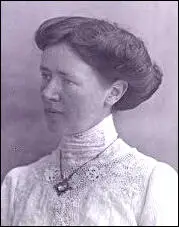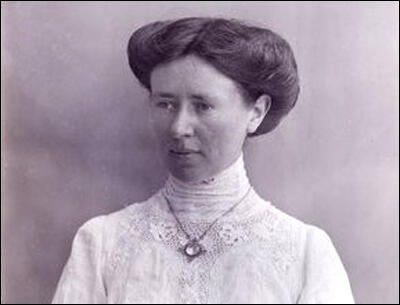Lillian Dove Willcox

Lillian Mary Dugdale, the third of four children, was born to Elizabeth Moore and Alfred Dugdale in Horfield, Gloucestershire, on 25th January 1877. Her father was a "Master Mariner". (1)
On 19th August 1903, Lillian Dugdale married Arnold William Dove Willcox, an "Assistant Manager in a Leather Factory". On 8th July 1907, Arnold William Dove Willcox died, leaving effects valued at £4,799 to his widow, Lilian Mary Willcox. (2)
After the death of her husband she joined the Women Social & Political Union in Bristol. On 29th June 1909 she was arrested after taking part in the WSPU deputation to the House of Commons and was sentenced to a month's imprisonment. (3)
While in Holloway Prison Lilian Dove Willcox went on hunger-strike. She also assaulted a wardress and was sentenced to a further ten days' imprisonment. Mary Blathwayt recalled what happened when she was released from prison: "We drove down to Bristol station, and formed up into a procession; it was to receive Mrs. Dove Willcox and Miss Mary Allen, two ex-prisoners and hunger strikers on their return to Bristol. A military band had promised to play, but they declined at the last moment. First came a carriage containing Mrs. Dove Willcox, and Miss Mary Allen; Annie Kenney and some others walked just behind it and then followed a long procession of ladies with banners and tricolour." (4)
In 1909 Dove Willcox worked alongside Annie Kenney, Clara Codd, Marie Naylor, Vera Holme and Elsie Howey in the West of England campaign. During this period she became a frequent visitor to Eagle House near Batheaston, the home of fellow WSPU member, Mary Blathwayt. Her father, Colonel Linley Blathwayt was sympathetic to the WSPU cause and on 10th May 1910 he planted a tree, a Picea Orientalis, in her honour in his suffragette arboretum in a field adjacent to the house.
On 18th November 1910, Dove Wilcox took part in a demonstration at 10 Downing Street against the failure of Herbert Asquith and his government to pass legislation to give women the vote. Votes for Women reported that 159 women and three men were arrested. (5) This included Dove Willcox, Catherine Marshall, Eveline Haverfield, Anne Cobden Sanderson, Mary Leigh, Vera Holme, Louisa Garrett Anderson, Kitty Marion, Clara Giveen, Eileen Casey, Ada Wright and Grace Roe. (6)

Dove Willcox replaced Annie Kenney as secretary of the Bristol branch of the WSPU in 1911. Christabel Pankhurst began useing the WSPU newspaper, Votes for Women, to advocate the hunger-strike. "The spiritual force which they are exerting is so great that prison walls are rent, prison gates forced open, and they emerge free in body as they have never for an instant ceased to be... Those who, in these latter days, are privileged to witness this triumph of the spiritual over the physical, understand the true meaning and manner of the miracles of old times." (7) Dove Willcox agreed with this strategy and was willing to employed her home as a place where hunger-strikers, such as Mary Richardson, could recover from their ordeal. (8)
A number of significant figures in the WSPU left the organisation over the arson campaign. This included Lillian Dove Willcox, Elizabeth Robins, Jane Brailsford, Laura Ainsworth, Eveline Haverfield and Louisa Garrett Anderson. Leaders of the Men's League For Women's Suffrage such as Henry N. Brailsford, Henry Nevinson and Laurence Housman, argued "that militancy had been taken to foolish extremes and was now damaging the cause". (9)
Some leaders of the WSPU such as Sylvia Pankhurst, disagreed with this arson campaign. In 1913, Pankhurst, with the help of Mary Dove Willcox, Keir Hardie, Norah Smyth, Julia Scurr, Mary Phillips, Millie Lansbury, Eveline Haverfield, Maud Joachim, Jessie Stephen, Nellie Cressall and George Lansbury and Zeli Emerson, established the East London Federation of Suffragettes (ELF). An organisation that combined socialism with a demand for women's suffrage it worked closely with the Independent Labour Party. (10)
As June Hannam has pointed out: "The ELF was successful in gaining support from working women and also from dock workers. The ELF organized suffrage demonstrations and its members carried out acts of militancy. Between February 1913 and August 1914 Sylvia was arrested eight times. After the passing of the Prisoners' Temporary Discharge for Ill Health Act of 1913 (known as the Cat and Mouse Act) she was frequently released for short periods to recuperate from hunger striking and was carried on a stretcher by supporters in the East End so that she could attend meetings and processions. When the police came to re-arrest her this usually led to fights with members of the community which encouraged Sylvia to organize a people's army to defend suffragettes and dock workers. She also drew on East End traditions by calling for rent strikes to support the demand for the vote." (11)
Norah Smyth supplied most of the money for this venture. Appointed treasurer of the EFL she helped finance their weekly newspaper, The Women's Dreadnought that first appeared in March 1914. Although they printed 20,000 copies, by the third issue total sales were only listed as just over 100 copies. During processions and demonstrations, the newspaper was freely distributed as propaganda for the EFF and the wider movement for women's suffrage. (12)
On 3rd June 1914, at St Pancras, London, Lillian Mary Dove-Willcox married 32-year-old journalist Reginald Ramsden Buckley. This union produced a daughter named Diana Gabrielle Buckley (1915-2008). Buckley, aged 37, died in a London hospital on 21st March 1919, leaving effects valued at £4,313.
Between 1924 and 1960, Lillian Mary Buckley lived at various addresses in Hampstead, London. When the 1939 National Register was compiled, she was residing at 156 Haverstock Hill, Hampstead, London, with her unmarried older sister Caroline Elizabeth Dugdale. In 1952, Lillian Mary Buckley was living at 15 Lyndhurst Road, Hampstead, London NW3. (13)
Lillian Dove Willcox was living at 44 Marlborough Road, Ealing East, when she died in 1963.
Primary Sources
(1) Mary Blathwayt, diary entry (4th September, 1909)
We drove down to Bristol station, and formed up into a procession; it was to receive Mrs. Dove Willcox and Miss Mary Allen, two ex-prisoners and hunger strikers on their return to Bristol. A military band had promised to play, but they declined at the last moment. First came a carriage containing Mrs. Dove Willcox, and Miss Mary Allen; Annie Kenney and some others walked just behind it and then followed a long procession of ladies with banners and tricolour. I helped to carry a banner marked Finland. A very long line of carriages followed. The roads were muddy and it rained a little at first.
(2) Dundee Evening Telegraph (23rd November, 1910)
Scenes of violence unparalleled in the history of the women's suffrage movement took place in Downing Street, Westminster. For over a quarter of an hour some 300 women members of the Women's Social and Political Union fought fiercely and with the utmost determination in the endeavour to break through the cordon of police which had been hastily drawn up at the entrance to the street in order to guard No 10, the residence of the Prime Minister, which was the objective of the women ...
Exactly 100 arrests were made, including some of the leaders of the suffrage movement. Later, following on a second concerted attempt to get to Mr. Asquith's house, several more arrests were made... The following is a list of the Suffragettes arrested: Emmeline Pankhurst, Catherine Marshall, Evaline Haverfield, Maude Sennett, Mary Leigh, Vera Holme, Louisa Garrett Anderson, Bertha Brewster, Kitty Marion, Clara Giveen, Eileen Casey, Lilian Dove-Wilcox and Grace Roe.
(3) David Simkin, Family History Research (16th September, 2022)
Mabel Lillian (Lilian) Dove-Willcox was born Lilian Mary Dugdale in Horfield, Gloucestershire, on 25th January 1877 (birth registered in the Gloucestershire district of Clifton during the First Quarter of 1877).Lilian was the third of four children born to Elizabeth Moore and Alfred Dugdale (c.1836-1906), a "Master Mariner". (Alfred Dugdale was later employed as the "Clerk of Bristol Market" ). When Lilian married her second husband in 1914, she described her late father as a "Naval Captain").
On 19th August 1903, Lilian Mary Dugdale married Arnold William Dove Willcox (1878–1907), an "Assistant Manager in a Leather Factory". (I believe Arnold's father owned the leather factory). On 8th July 1907, Arnold William Dove Willcox , described as a "leather factor", died, leaving effects valued at £4,799 to his widow, Lilian Mary Willcox. .
On 3rd June 1914, at St Pancras, London, Mrs Lilian Mary Dove-Willcox, who described herself as a 36-year-old widow (she was actually 37) married 32-year-old Reginald Ramsden Buckley (1882-1919) , described on the marriage register as an " Author " and the son of a "Cotton Manufacturer ". (On the 1911 Census return, Reginald Ramsden Buckley is recorded as a "Journalist"). This union produced a daughter named Diana Gabrielle Buckley (1915-2008) - there is a painted portrait of Diana on Ancestry. Reginald Ramsden Buckley died in a London hospital on 21st March 1919, leaving effects valued at £4,313.
Between 1924 and 1960, Mrs Lilian Mary Buckley lived at various addresses in Hampstead, London. When the 1939 National Register was compiled, Mrs Lilian M. Buckley (a "retired" widow) was residing at 156 Haverstock Hill, Hampstead, London, with her unmarried older sister Caroline Elizabeth Dugdale (born 17th May 1868) described as a "Social Worker & Lecturer - retired ". In 1952, Mrs Lilian Mary Buckley was living at 15 Lyndhurst Road, Hampstead, London NW3.
During the early 1960s, Mrs Lilian Mary Buckley moved from Hampstead to Ealing , Middlesex. The electoral register for 1963-1964 records Lilian M. Buckley at 44 Marlborough Road, Ealing East.
The death of Mrs Lilian Mary Buckley was registered in Ealing, Middlesex , during the 4th Quarter (Oct-Nov-Dec) of 1963. She was 86 years old at the time of her death.

